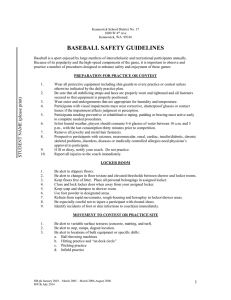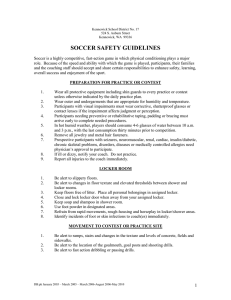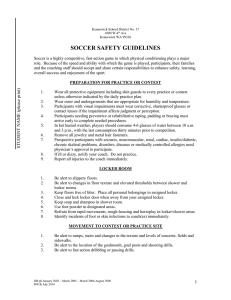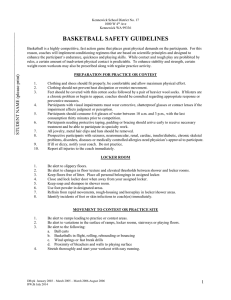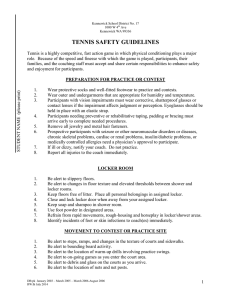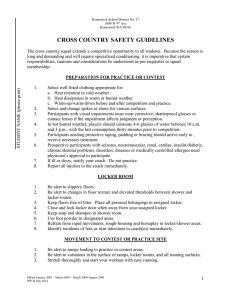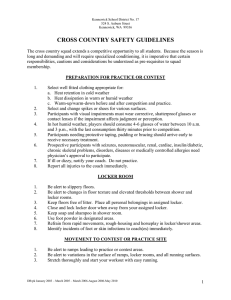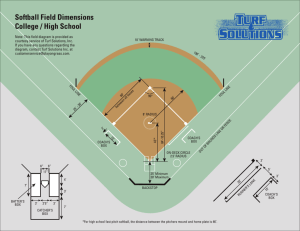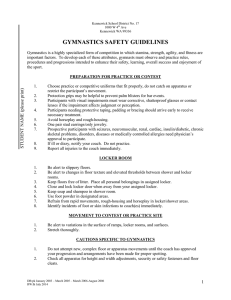SOFTBALL SAFETY GUIDELINES
advertisement
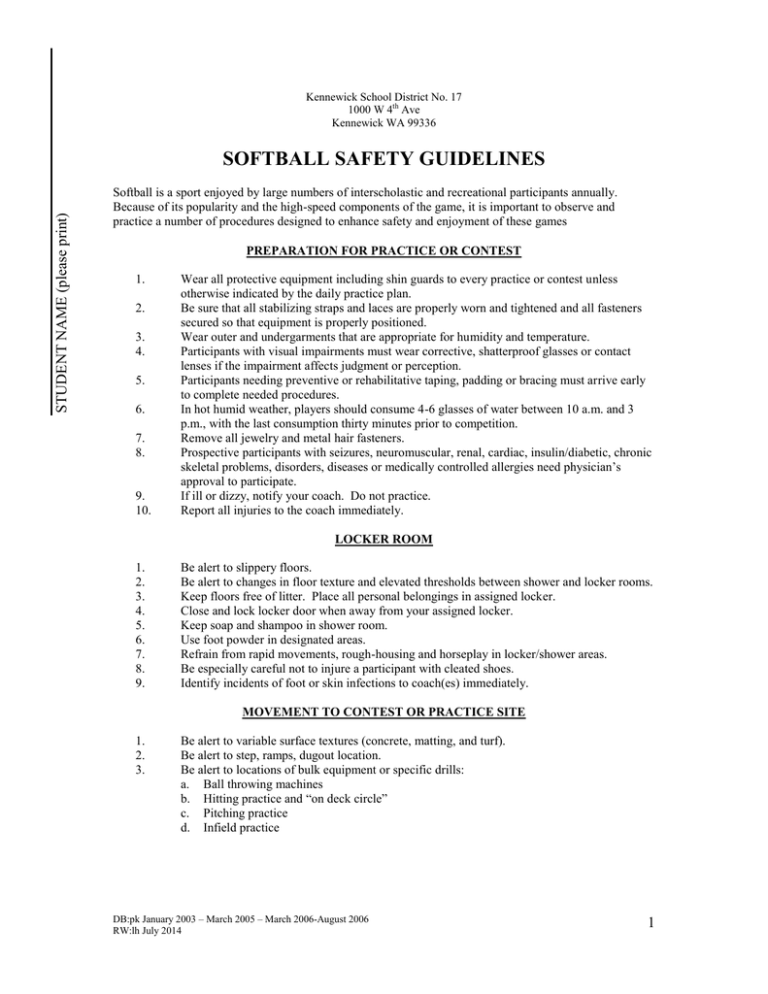
Kennewick School District No. 17 1000 W 4th Ave Kennewick WA 99336 STUDENT NAME (please print) SOFTBALL SAFETY GUIDELINES Softball is a sport enjoyed by large numbers of interscholastic and recreational participants annually. Because of its popularity and the high-speed components of the game, it is important to observe and practice a number of procedures designed to enhance safety and enjoyment of these games PREPARATION FOR PRACTICE OR CONTEST 1. 2. 3. 4. 5. 6. 7. 8. 9. 10. Wear all protective equipment including shin guards to every practice or contest unless otherwise indicated by the daily practice plan. Be sure that all stabilizing straps and laces are properly worn and tightened and all fasteners secured so that equipment is properly positioned. Wear outer and undergarments that are appropriate for humidity and temperature. Participants with visual impairments must wear corrective, shatterproof glasses or contact lenses if the impairment affects judgment or perception. Participants needing preventive or rehabilitative taping, padding or bracing must arrive early to complete needed procedures. In hot humid weather, players should consume 4-6 glasses of water between 10 a.m. and 3 p.m., with the last consumption thirty minutes prior to competition. Remove all jewelry and metal hair fasteners. Prospective participants with seizures, neuromuscular, renal, cardiac, insulin/diabetic, chronic skeletal problems, disorders, diseases or medically controlled allergies need physician’s approval to participate. If ill or dizzy, notify your coach. Do not practice. Report all injuries to the coach immediately. LOCKER ROOM 1. 2. 3. 4. 5. 6. 7. 8. 9. Be alert to slippery floors. Be alert to changes in floor texture and elevated thresholds between shower and locker rooms. Keep floors free of litter. Place all personal belongings in assigned locker. Close and lock locker door when away from your assigned locker. Keep soap and shampoo in shower room. Use foot powder in designated areas. Refrain from rapid movements, rough-housing and horseplay in locker/shower areas. Be especially careful not to injure a participant with cleated shoes. Identify incidents of foot or skin infections to coach(es) immediately. MOVEMENT TO CONTEST OR PRACTICE SITE 1. 2. 3. Be alert to variable surface textures (concrete, matting, and turf). Be alert to step, ramps, dugout location. Be alert to locations of bulk equipment or specific drills: a. Ball throwing machines b. Hitting practice and “on deck circle” c. Pitching practice d. Infield practice DB:pk January 2003 – March 2005 – March 2006-August 2006 RW:lh July 2014 1 CAUTIONS SPECIFIC TO SOFTBALL 1. 2. 3. 4. 5. 6. 7. 8. 9. All protective equipment required by rule must be worn at practice and competition in those situations that require it. Helmets are to be worn by batters, base runners, catchers, and base coaches. “On deck” hitters are to take practice swings in a designated circle but with complete attention directed to the pitcher and batter. If no circle is designated, stand behind the backstop. Keep hand off the backstop. Swing only one bat when taking practice swings. Use a bat ring that will not slide off the thick end of the bat. Batting practice, infield drills, outfield drills and pitching practice are to be done in designated areas and at designated times. DO NOT begin these practices without the direction of the coach. Sliding is only to be performed in the manner taught and approved by the coach BEFORE it is tried. Offensive and defensive participants involved in sliding or other close plays must recognize the possibility of being hit by a thrown ball, being bumped accidentally, or of being injured by friction burn or being stepped on. Be alert to the location of the ball and opponents. Assume a protected position. Do not leave limbs extended when on the ground. Burns, sprains, strains, and contusions must be report to coaches. Dugout participants on the field must be alert to its location when making defensive plays. Participants in the dugout must be alert to foul balls, overthrows or defensive participants moving toward the dugout at high speed. EMERGENCIES Because of the nature of softball some injuries may occur. Most will be minor and can be managed with basic first aid, but the possibility of a serious injury is always present. All injuries must be called to a coach’s attention. An occasional situation may require more intense management and may also necessitate involvement of participants as follows: 1. 2. 3. 4. 5. Stop all practices. Call the coach to manage the situation if the coach is not already at the site. Sit or kneel in close proximity. Assist by: a. Calling for additional assistance b. Bring the first aid equipment or supplies to the site c. Keeping onlookers away d. Directing rescue team members to the site Fire or fire alarm: a. Evacuate or remain outside the building b. Move 100 feet from the building c. Be prepared to implement the emergency procedures outlined in #4 above. I understand the rules and procedures and the necessity of using the proper techniques while participating in softball activities. Student Signature ______________________________________ Date ___________________ Parent/Guardian Signature _______________________________ Date ___________________ DB:pk January 2003 – March 2005 – March 2006-August 2006 RW:lh July 2014 2
